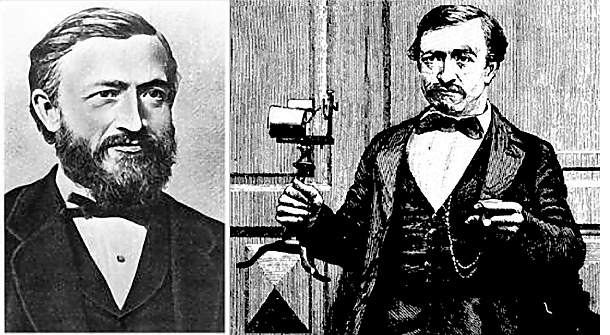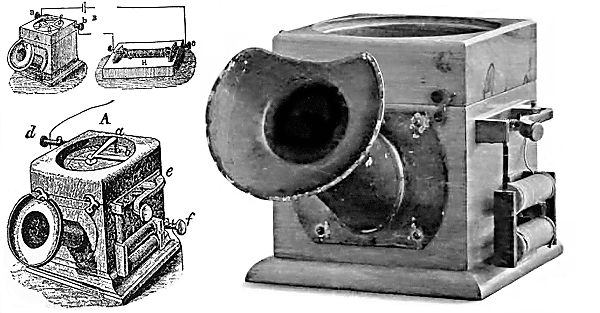Past Entry of Zippy's Telecom Blog
More Previous Columns
January 14, 2011
Who Really Invented the Telephone? Part 1 — Johann Philipp Reis (1834–1874)
In 1860 after eight years of research, a brilliant though sickly and impoverished 26-year-old teacher in Germany named Johann Philipp Reis built the first in a series of different telephonic devices, each of which he called das telephon.

Figure 1. A photo and an engraving of Johann Philipp Reis with the seventh version of his telephone, demonstrated before the Free German Institute in Frankfurt on May 11, 1862. A tenth version was marketed in Europe before Alexander Graham Bell applied for his patent in 1876.
As in the case of later researchers such as Alexander Graham Bell, Reis’ initial ideas for inventing a telephone involved mimicking the construction of the human ear. Reis knew that the ear consists of an outer ear shaped like a cup that collects sounds and concentrates them through an ear canal that channels the sound waves toward the middle ear. Here, a membrane, or eardrum that covers the opening of the middle ear vibrates in sympathy with the waves of sound impinging upon it, and these vibrations in turn are transferred to the hammer, anvil and stirrup bones that multiply the force and pressure of the vibrations. The stirrup bone then transfers the vibrations to the Cochlea (inner ear) a spiral shaped tube, the interior of which is lined with small hairs or “cillia” that activate nerve cells in the auditory nerve which finally conveys the electrical signals corresponding to sounds to the brain.
Reis may have known about Bourseul’s work as he used Bourseul’s phrase, “make and break,” in his writings. He certainly knew of Professor Page’s work, and therefore hoped that if he made an artificial diaphragm resembling an eardrum, its vibrations could be used to “make and break” the circuit of an electric current, and this current could set up similar vibrations in a distant receiver using a coil like that of Professor Page, where an iron needle would reproduce the original sound waves that had vibrated the transmitting diaphragm. Page’s 1837 experiment had demonstrated that an interrupted current would produce corresponding “ticks” in a needle-and-coil combination thanks to the principle of magnetostriction, a phenomenon wherein a metal rod’s length varies as the magnetic field through it varies.
Reis began research on an “artificial ear” (künstliches Ohr) in 1852. Laboring in a small workshop behind his home at Friedrichsdorff, Reis’ first transmitter consisted of the “bung” or wooden plug of an oak beer barrel, carved out to make it look something like a human ear. This mouthpiece collected sounds, focusing them to a diaphragm made from the casing skin of a German sausage! To the back of this he fixed, with a drop of sealing-wax, a little strip of platinum that substituted for the human ear’s hammer-bone. The platinum strip was in loose contact with an electrical point contact; the variable resistance of this imperfect contact was used to modulate the signaling current: as the diaphragm oscillated in accord with the sounds impinging against it, the platinum strip rose and fell, making and breaking an electric circuit synchronous with the vibrations. Moreover, Reis theorized (somewhat mistakenly, as it turned out) that as the metal point bounced up and down, the height of the bounce, the force of its return, and the amplitude of the current pulse would vary with the sound’s intensity, and would therefore convey a measure of the sound’s quality as well as intensity.
The interrupted current thus crudely modulated was conveyed by wires to the receiver, which consisted of a steel knitting needle loosely surrounded by a coil of wire serving as an electromagnet. The coil was fastened to a violin that served as a sounding board.
A musical note played near the bung would vibrate the drum, cause the platinum strip to periodically interrupt the metallic circuit, the current of which traveled via the wire and passed through the receiver’s coil, the varying magnetic field of which vibrated the needle and made the sound of the original tone. As primitive as this configuration appears, it was said to amaze anyone who heard it.
In July 1860 Reis had privately demonstrated the transmission of a melody over a distance of about 100 meters (about 328 feet) through a two conductor wire strung from his workshop to a barn in back of his house.
Later, more sophisticated and improved versions of Reis’ telephones used a bent and pivoted lever of platinum, making it open and close a springy contact of platinum foil in the metallic circuit. The spring was to close the contact after it had been opened by the shock of each individual sound wave. This arrangement worked extremely well if the sound transmitted was a pure musical tone, which is an orderly succession of vibrations. But speech is very complicated and subtle; the constituent sound waves are not digital “all or nothing” entities. Instead, they are continuously varying waves. One cannot reproduce them by simply interrupting the current; instead, the current must be continuously varied in strength, undulating in smooth sympathy with and thus duplicating the original oscillations of the air. Reis’ primitive platinum contacts were thus an inferior forerunner of the modern microphone.
At some point in 1860 or early 1861, Reis believed his device could transmit intelligible speech. Supposedly, the first words sent were “Ein Pferd frisst keinen Gurkensalat” which translates to English as “A horse does not eat a cucumber salad.” (Not exactly as dramatic as Bell’s “Mr. Watson—come here—I want to see you,” but I suppose it served its purpose).
Reis revealed his most up-to-date version of das telephon to the scientific community in a lecture and demonstration on “Telephony Using Galvanic Current” (Das Telefonieren durch galvanischen Strom) before the Physical Society (Der Physikalische Verein) of Frankfurt-am-Main on October 26, 1861. It was during this lecture that Reis coined the now-familiar word “telephony.” During the demonstration, Reis transmitted the verses of a song from the lecture room to a hospital room over a 330-foot (100 meter) wire. Reis then wrote a description of his device for the Society’s Jahresbericht (“Annual Report”), which appeared about two months later.
German scientists were well informed of the Reis telephone and soon identified its shortcomings.
Around the time Reis demonstrated his telephone to the Free German Institute in Frankfurt on May 11, 1862, a report entitled “Reproducing Sounds on Extra Galvanic Way,” was published by Wilhelm von Legat, Inspector of the Royal Prussian Telegraph Corps. Von Legat stated that the inventor was aware of the theoretical problems associated with the way his transmitter entirely broke the circuit of the current, though the fundamental design of the device seemed to prohibit adopting other approaches. Other parts of the Reis telephone also caused problems, such as the sausage skin diaphragm that could loosen or tighten depending on the surrounding atmosphere’s humidity.
Still, Reis’ telephones could electrically transmit both music and, to some degree, speech. The controversy surrounding the Reis phone centers on what happens when the sound entering a Reis transmitter isn’t loud enough to break the contact with the platinum strip and the point contact. Some experts believed that the pressure of the platinum strip on the point contact would continuously fluctuate along with the sound, causing matching fluctuations in the electrical resistance and therefore in the current. The receiver’s design did allow it to respond to both such continuously fluctuating as well as to the regular intermittent currents, though not by magnetostriction. But because there was no signal amplification available at the time, the more delicate waveforms would have been drowned out by the sound of the intermittent pulses. The device’s sensitivity to transmitting and receiving complex sounds would thus be extremely low, too low for the robust, audible reproduction of speech. If it could have been proved otherwise, however, the Reis telephone would constitute “prior art” and the Bell patents would be invalid.
In a comprehensive textbook of that century, Electricity and Magnetism by Amedee Guillemin (Illinois: McMillan & Son, 1891), there is a description of how well a Reis telephone performed:
The sounds transmitted by Reis’s telephone are rather weak and muffled. Moreover they do not perfectly preserve the timbre peculiar to the sounds imparted to the transmitter. Nevertheless they permitted differences in quality to be observed. Professor Bohn says that in the early experiments of 1864, the son of Privy Councillor Jhering of Giessen was found to be a better speaker through the telephone than most other persons, and that it was easy to distinguish the voice of a boy from that of a girl. Reis himself states that, when chords struck on the piano were transmitted, a person having a musical ear could in the majority of cases distinguish the various notes in the chord....
Reis’ telephones were not designed for true mass-production or commercial exploitation, but rather as fragile laboratory models meant to encourage the scientific investigations of others. Indeed, more than 50 authorized reproductions of das telephon were sold and found their way to investigators in places such as Dublin, London, and Tiflis in Russia. One Reis telephone was demonstrated in Scotland during the time Alexander Graham Bell was there visiting his father. No one knows if Bell saw it, but there is a reasonably high probability that he was familiar with the work of Reis and others in telephony.

Figure 2. The top left view of the Reis Telephon system is from the 1897 Encyclopedia Britannica, but it doesn’t show as much detail as the engraving at the bottom, which is the tenth and (probably) final form of Reis’ telephone, made in 1862. Several of these phones were built by the mechanical workshop of Johann Valentin Albert Sohn and sold to experimenters starting in 1863, one of which is seen in the photo at right.
Reis’ celebrity was brief, as scientists of the day soon regarded his telephone merely as an interesting curiosity. In 1867 an angry Reis recanted his membership in the now-indifferent Physical Society of Frankfurt-am-Main. Likewise, the Free German Institute of Frankfurt, which had elected Reis an honorary member, soon belittled his telephone, calling it a “philosophical toy”.
Even so, the “Telephone” entry of the Encyclopedia Britannica’s 1911 edition states that, “The [Reis] instrument was described in over fifty publications in many countries and was well known to physicists prior to Bell’s introduction of the electric telephone as a competitor with the electric telegraph.”
In 1863 Dr. Otto Volger, Founder and President of the Free German Institute (Freies Deutsches Hochstift) demonstrated a Reis telephone to the Emperor of Austria and to King Max of Bavaria, who both happened to be visiting Frankfurt.
Americans expressed a bit more interest in Reis’ invention. In 1872, Prof Vanderwyde demonstrated Reis’s device in New York where it was seen by Thomas Edison, and possibly officials of Western Union and perhaps even Alexander Graham Bell. Bell, Edison and Emile Berliner used Reis’s device as the basis of their own later development of essential telephone components.
A sickly man who suffered from tuberculosis, Reis died on January 14, 1874, still believing that what had been disparaged as a toy would one day be appreciated by future generations.
Interestingly, on March 22, 1876, just 12 days after Alexander Graham Bell’s famous first phone call to Dr. Watson, a New York Times editorial entitled, “The Telephone” praised the late Johann Philipp Reis as its inventor, ignoring Bell entirely.
As Amedee Guillemin wrote in 1891:
Strange to say, although Reis’s telephones were sent all over the world, this brilliant invention passed into almost utter oblivion. Many misconceptions prevailed at one time about the nature of Reis’s invention, and attempts were made to stigmatize it as a mere musical toy. Persons were found, in particular lawyers who were paid for what they said, to declare that Reis’s apparatus never did and never would transmit speech, and ingenious theories were proposed to prove that it could not.
In 1878, just as the first commercial telephone exchanges were appearing, the now repentant Physical Society of Frankfurt-am-Main erected a monument over Reis’ grave in Friedrichsdorff consisting of a red sandstone obelisk bearing a medallion portrait of “the inventor of the telephone”.
The Reis telephone was later used as a tool in lawsuits by those wishing to invalidate the Bell patents. Reis’ supporters in America believed that the carbon microphones of Edison, Blake, Berliner and others were all derived from Reis’ inferior make-and-break transmitter, though admittedly the far superior concept used in the carbon microphone (variable resistance modulated by sound waves impinging on a diaphragm) made possible not only high-quality telephony, but radio and phonographs as well.
It was “not in any sense a speaking telephone,” said William Thomson (Lord Kelvin) (1824-1907). Of course he may have been a bit prejudiced since he was the one who introduced Bell’s telephone into Britain. And Edison, while participating in a lawsuit that attempted to break the Bell patents, admitted humorously that when he used a Reis transmitter he generally “knew what was coming; and knowing what was coming, even a Reis transmitter, pure and simple, reproduces sounds which seem almost like that which was being transmitted; but when the man at the other end did not know what was coming, it was very seldom that any word was recognized.”
Judge Lowell of the U.S. Circuit Court of Massachusetts ultimately ruled that “The deficiency was inherent in the principle of the machine. . . . Reis would never have produced a speaking telephone.” (The Telephone Cases, 126 U.S. 1, 193 (1888)). John Brooks, in his book, Telephone: The First Hundred Years (New York: Harper & Row, 1976) quotes a curator of the division of electricity of the Smithsonian Institution who thought that certain small changes to the Reis telephone would have enabled it to successfully transmit speech. Interestingly, if one replaces the platinum contacts on a Reis telephone with carbon ones, the device performs beautifully, much like a conventional carbon microphone. Perhaps if Reis had not died at such a youthful age, he could have stumbled upon a design for a dependable telephone capable of transmitting more than a few words or sounds at a time.
As we sometimes say in America—“close, but no cigar.”
German textbooks continued to laud Reis as the telephone’s true inventor for nearly 60 years after his death, but Reis, who was a Jew, received a final indignity with the rise of the Nazis, who obliterated any mention of him in their scientific or historical literature.
A BBC News article dated Monday, December 1, 2003 (http://news.bbc.co.uk/1/hi/sci/tech/3253174.stm), reveals the astonishing contents of documents discovered in October 2003 in London’s Science Museum by the museum’s Curator of Communications, John Liffen. The documents reveal that U.K. businessman Sir Frank Gill, while chairman of the British firm, Standard Telephones and Cables (STC) in 1947, conducted a cover-up when STC engineers tested an 1863 model of Reis’ phone. The technicians found that, after a bit of tinkering, it could be made to “reproduce speech of good quality but of low efficiency.” Gill, horrified, ordered that the tests be kept secret, since STC was at that time negotiating a lucrative contract with AT&T, the successor organization to the Bell Company, and feared that it would irritate them and thus disrupt the business negotiations.
A memo, dated 18 March 1947, from Gerald Garratt, the Science Museum’s communications curator at that time, show that STC’s reports on Reis’s device were given to the museum under the strict condition that they would never be publicly referred to or published without permission. Even so, STC subsequently became anxious to retrieve the documents. Later on, Garratt wrote: "I am left with the thought that there is something so secret about [the documents] as to be a matter of first class historic interest… You must know as well as I the old controversy: ‘Did Bell invent the telephone?’ and I have here an unpublished manuscript of over 400 pages which proves pretty conclusively that he didn't….”
Today the Reis home in Friedrichsdorf is a museum dedicated to the inventor (die Philipp-Reis Gedächtnisstätte) and operated by the Museumsstiftung Post und Telekommunikation. Since 1987 a prize, the Philipp-Reis-Preis, has been awarded at two year intervals to a promising German inventor under the age of 40 who has developed an important communications innovation.
Perhaps the best final words on Reis were written by Reis himself. Toward the end of his long illness, Reis looked back over his short life of 40 years and seemed to lose all of his former frustration and bitterness. In his curriculum vitae or resume, he wrote the following: “As I look back upon my life I indeed say with the Holy Scriptures that it has been ‘labour and sorrow.’ But I have also to thank the Lord that He has given me His blessing in my calling and in my family, and has bestowed more good upon me than I have known how to ask of Him. The Lord has helped hitherto; He will help yet further.” •
